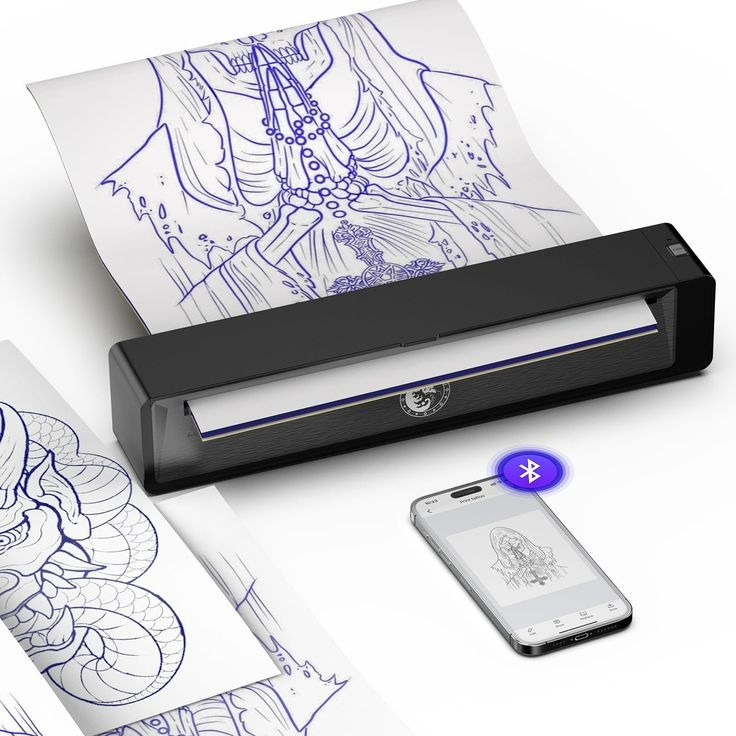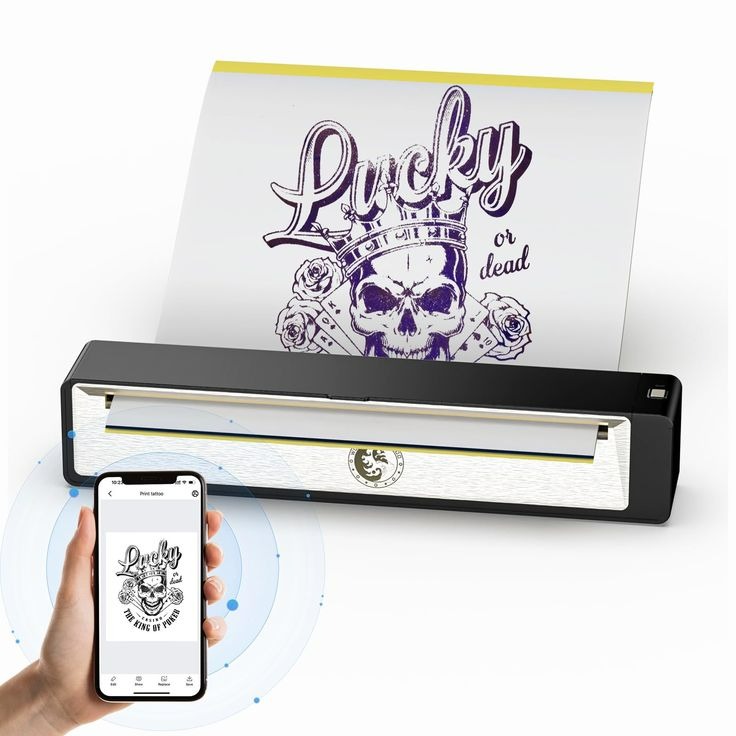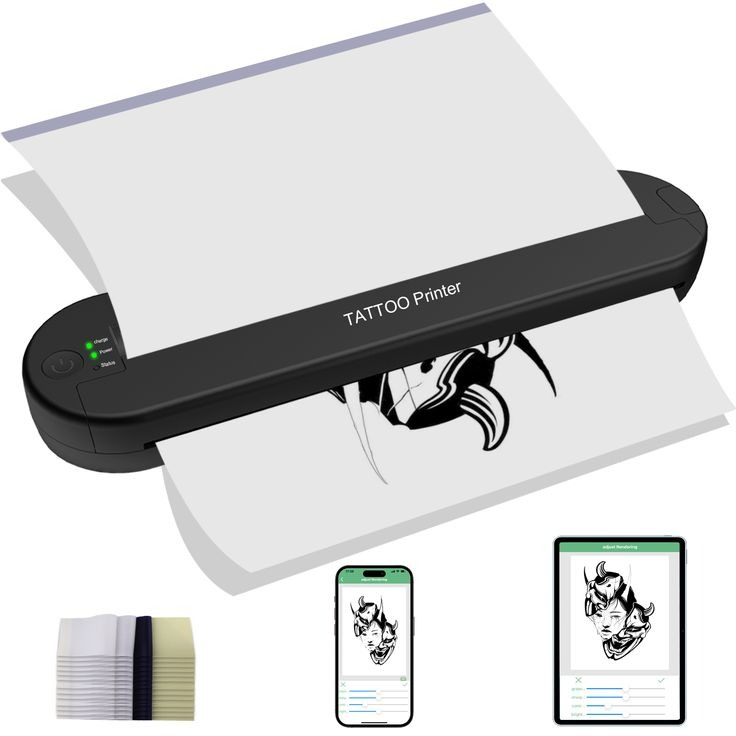Types of Tattoo Printers
Choosing the right type of tattoo printer is crucial for any tattoo artist. Different types come with varied features and benefits. Here we discuss the three common types of tattoo printers available in the market. Knowing the differences can help you select the best one for your needs.
Thermal Tattoo Printers
Thermal tattoo printers are popular among tattoo professionals. They work by transferring your designs onto stencil paper using heat. They are fast and efficient, making them ideal for busy tattoo studios. A key advantage is their ability to produce crisp and clear stencils, which are essential for detailed work. When considering a thermal tattoo printer, note its print quality and compatibility with different stencil papers.
Dot Matrix Tattoo Printers
Dot matrix tattoo printers, although older technology, are still used by some artists. These printers operate by striking a ribbon against the stencil paper, almost like a typewriter. They are more robust and can handle thicker papers. However, they tend to be slower and noisier than other types. Consider the speed and the type of designs you plan to print when looking at dot matrix options.
Inkjet Tattoo Printers
Inkjet tattoo printers are versatile and can print high-quality designs on various surfaces, including stencil paper. They use liquid ink to create stencils and often offer a wide range of color options for your designs. Although they provide high resolution and color accuracy, they may require more maintenance and frequent ink replacements. Check for user-friendly maintenance solutions and running costs.
Each type of tattoo printer has its advantages. The decision should depend on the requirements of your tattoo practice, including the types of designs you create and how often you need to print stencils. Always look for a tattoo printer that balances quality with efficiency to support your artistry in the best possible way.

Key Features to Consider
When looking for a tattoo printer, certain key features are important to consider. These features determine the effectiveness and usability of the printer for your tattooing needs.
Print Quality and Resolution
High print quality and resolution are vital for intricate tattoo designs. A printer that offers crisp images and sharp lines ensures stencils are accurate and detailed. Look for printers with high DPI (dots per inch) ratings for the best detail in your stencils.
Compatibility With Stencil Papers
Your printer must work with various stencil papers. Compatibility reduces the hassle of finding the right supplies. Check the printer’s specifications to ensure it supports the stencil paper you prefer.
Speed and Efficiency
Speed matters in busy tattoo shops. A fast printer can save you time and increase your workflow. Efficiency also includes the printer’s ability to handle multiple jobs or large designs quickly.
Connectivity Options
Consider how you will connect your designs to the printer. Some printers offer USB, wireless, or Bluetooth connectivity. Easy transfer of designs from your device to the printer can streamline your process. Look for printers that support your preferred method of connectivity.
Ease of Use and Maintenance
Ease of use and maintenance are key when choosing a tattoo printer. You want features that enhance simplicity and convenience.
User-Friendly Interface
A user-friendly interface is essential. Look for a tattoo printer with intuitive controls and clear instructions. This makes it easy to print stencils without stress. Simple menu navigation and touchscreen displays are plus points. They save time and reduce the learning curve for artists.
Maintenance Requirements
All printers need upkeep, but the goal is low maintenance. Choose a tattoo printer with straightforward cleaning procedures. Simple cartridge changes and jam-clearing steps are ideal. Look for models with self-cleaning features to cut down on manual work. Remember, less maintenance means more time to focus on your art.
Accessibility of Consumables
A good tattoo printer doesn’t just work well; it also has accessible consumables. Ink, toner, and stencil paper should be easy to find and replace. Look for printers with readily available supplies. This ensures you can keep your printer stocked and ready for any project. Check supply costs as well; affordable and easy-to-find consumables keep running costs low.

Size and Portability
When selecting a tattoo printer, consider the size and portability, especially if your workspace is limited or you travel often.
Compact Designs for Small Spaces
For artists working in smaller tattoo shops or home studios, a compact tattoo printer is a must. Look for models that fit comfortably on a desk without taking up too much space. This allows for more room to maneuver and focus on your art. Compact tattoo printers should offer the same high-quality printing without the bulk of larger models.
Portable Printers for Artists on the Go
If you’re a tattoo artist who attends conventions or does guest spots, portability is crucial. A portable tattoo printer that is light and easy to transport can be a game-changer. Ensure that it has sturdy construction to withstand the rigors of travel. Battery-powered options can free you from the need for electrical outlets, providing convenience on the move.
Cost and Budget Considerations
When choosing a tattoo printer, the cost is a major factor to weigh. Budgeting for both the purchase and the ongoing expenses is wise to avoid financial strain.
Initial Purchase Price
The initial purchase price of a tattoo printer varies. High-end models come with advanced features but have a hefty price tag. More budget-friendly options may have fewer features but can still be reliable. Determine what you need from a tattoo printer and set a limit on how much you are willing to spend. Check for deals or refurbished units to save money.
Long-Term Running Costs
After buying a tattoo printer, you’ll have ongoing costs. These include ink or toner, stencil paper, and maintenance supplies. Some printers have higher running costs due to expensive consumables or parts. Look for a printer with low-cost consumables to keep long-term expenses down. Research the average lifespan of printers to gauge potential replacement costs. Always consider running costs when calculating the total investment in your tattoo printer.
Durability and Reliability
When selecting a tattoo printer, its lifespan and trustworthiness are crucial. Consider these factors to avoid frequent replacements.
Build Quality
A sturdy tattoo printer endures daily use without fail. Seek machines with solid construction and materials that resist wear and tear. High build quality means fewer issues and repairs.
Manufacturer Warranties and Support
Warranties protect your investment in a tattoo printer. Choose brands that offer comprehensive warranties and reliable customer support. Good support services can help resolve any issues quickly.

Customer Reviews and Recommendations
Choosing the right tattoo printer is a significant decision. To aid in this choice, consider the experiences of those who’ve used them firsthand. Customer reviews and recommendations are valuable resources. They offer insights into performance, durability, and user satisfaction.
Professional Tattoo Artists’ Opinions
When browsing for a tattoo printer, seek out the opinions of established tattoo artists. They rely on these tools daily. Hence, their feedback on various brands and models is invaluable. Many professionals share reviews on industry forums or social media. Highlights include efficiency, the accuracy of stencils, and overall satisfaction. Look for consistent praise or concerns raised by multiple artists to gauge reliability.
User Testimonials
Feedback from a broader user base also provides a well-rounded view of tattoo printers. Many users post their testimonials on online retail websites or video platforms. They often discuss aspects such as ease of use, maintenance needs, and customer service experiences. Positive testimonials can reassure you of a printer’s quality. On the other hand, frequent complaints can be a red flag. Balance professional artists’ opinions with user testimonials to get a comprehensive perspective.